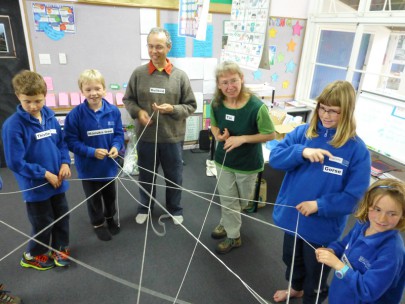Haast School, Westland
In this section
-
Participating schools
- Curious Minds visit Lincoln
- Franz Josef & Fox Glacier Schools
- Greymouth High School
- Haast School
- Halswell Domain
- Halswell School
- Heathcote Valley School
- Kaniere School
- Kaniere visit Lincoln
- Hokitika Primary
- Leeston Consolidated School
- Manuka Primary School
- Mission Heights
- Mt Albert Grammar
- Paroa School
- Rudolf Steiner School
- Takapuna Grammar
- TKKM
- Wakaaranga Primary School
- Whataroa School
This was the third school visited by Murray Dawson (MWLR) and Robinne Weiss (our educator). Jon Sullivan, iNaturalist NZ guru and weed ecologist from Lincoln University was also able to join us on our long journey south to Haast.

Learning about the Web of Life with Jon Sullivan and Robinne Weiss.
Upon arrival at the school, we were warmly greeted by their Principal, Michelle Green, who made us very welcome. They have a lovely school that is well resourced. The teachers are professional and the students attentive making it a pleasure to work with them all. There were relatively few pupils (11 of them, from Y3–6), as can be expected from such a remote location. However, they pointed out that they don't really feel remote with the internet connecting them to the rest of the world.
We were amazed at how environmentally aware the students are, no doubt helped by the positive role that the Department of Conservation have in the local community. We were told that DOC staff regularly visit the school. For Conservation Week the previous month (10–18th September), DOC showed the students how to set up track-lines behind their school (rat and maybe stoat tracks were observed). The first day we visited, the local DOC staff showed off a Fiordland crested penguin that they were nursing back to health before release. DOC held a school discussion on the biology of these penguins.
The first day was classroom based, and Robinne led the kids through our programme of weed activities. Jon and I collected some plants from the rainy outdoors to bring into the classroom for study.
During the second day, the students used our smartphones and apps to record and identify plants found in the school grounds and adjacent areas.
Haast School later nominated their Y6 student Charlotte to visit our research centre at Lincoln to learn more about weeds and biological control.
What were some of the plants that we found?
The school backs onto the coast with a narrow strip of windswept native forest between the school grounds and the sea. It was great to see few weeds along this area, and relatively few weeds in the school grounds. We didn't find many of the environmental weeds seen further north in Westland, such as Himalayan honeysuckle (Leycesteria formosa), privet (Ligustrum), Scotch broom (Cytisus scoparius), tradescantia (Tradescantia fluminensis), tutsan (Hypericum androsaemum) or wild cherry (Prunus).
The school has actively removed most agapanthus that were growing in their front gardens, but we found some remnants that were re-sprouting there.
Unsurprisingly, montbretia (Crocosmia × crocosmiiflora) was found in the school grounds. Montbretia is abundant in Westland, along with the ubiquitous gorse.
We talked to the class about hydrangea, explaining that it is often seen in Westland persisting in former gardens long after the original houses are gone. Hydrangea can also spread by seed from these old remnant plantings.
Some of the native plants observed by the students (as 'by-catch') included:
- kotukutuku (Fuchsia excorticata)
- leather-leaf fern (Pyrrosia eleagnifolia)
- Leptinella squalida subsp. mediana
- pohuehue (Muehlenbeckia australis).
After we finished teaching at the school, we made some observations of the wider Haast area along what is generally considered to be a relatively pristine coastline.
We saw coastal developments north of Haast School – large blocks of land cleared of what had been a continuous coastal strip of indigenous forest. We wondered about the wisdom of removing this living barrier protecting the land from the sea and coastal gales.
Along this coastline, where there are several small communities, we also saw the too-familiar pattern of exotic plantings escaping from nearby gardens into the surrounding environment.
At Okuru River we found giant gunnera persisting from a roadside dumping at the edge of the settlement, where there was also lots of agapanthus planted.
At Jackson Bay, as far south as the road takes you on that coast, we saw one property with extensive plantings of arum lily (Zantedeschia aethiopica) growing along one boundary and escaping into nearby roadside areas. The same property has Mexican daisy (Erigeron karvinskianus) planted along its front retaining wall. Both are major environmental weeds that are being cultivated alongside a vulnerable natural area.
Nearby, Jon found some ivy growing on a stream-bank and collected a specimen for the Allan Herbarium. He later identified it as Canary Islands ivy (Hedera canariensis) and told us that it is often confused with English ivy (Hedera helix). The main separable character is the stellate (star-shaped) hairs on the leaf stalks (petioles) which require a hand lens or microscope to see. Also at Jackson Bay, we saw a pohutukawa (Metrosideros excelsa) tree planted on the foreshore, surely the most southerly planting of this species in Westland.













